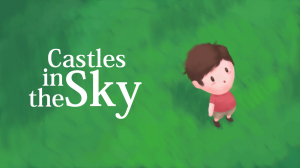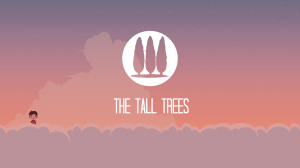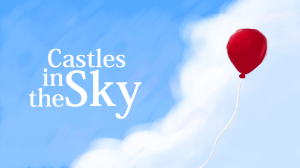Game:
Castles in the Sky
Developer:
Release Date :
2013
Platform:
PC/Mac
Reviewed on PC
The Sound Architect have the privilege of playing Castles in the Sky, the first game from The Tall Trees. The Tall Trees was founded by BAFTA Award winner Dan Pearce (10 Second Ninja) and Jack de Quidt. Read our audio review to gain insight into this beautiful indie game.
In Castles in the Sky you play as a young boy on a journey through the clouds, by jumping and riding balloons to search for castles in the sky. Another beautifully simple indie game that is also highly addictive. The first emotion that springs to mind is calmness. To coin yet another infamous phrase I would say it gives a feeling of emotional tranquility.
The music in the beginning and throughout is as sweet and simple as the game itself with piano and cello. It is music that puts you at ease. Leading a stressful busy life means we don’t take time out to enjoy ourselves too much. Even with games we tend to play high paced, or highly stressful and difficult games. This game is as pure and simple as it’s music. I highly recommend playing this game in a break from the stressful world around you. It even has beautiful written narrative to go alongside the emotional music.
 The SFX in Castles in the Sky compliment the music literally as they are beautiful bells that are in the same key as the music. As you climb up through the clouds using balloons, or your crazy gift of super high jumping, you create twinkly arpeggios and notes to add to the calming music surrounding you. They do actually sound like a mix between bubble-wrap and a synthesized shatter. For the soundscapes themselves, the clever use of night time sounds adds to the peaceful isolation, although a little unorthodox for space, it works!
The SFX in Castles in the Sky compliment the music literally as they are beautiful bells that are in the same key as the music. As you climb up through the clouds using balloons, or your crazy gift of super high jumping, you create twinkly arpeggios and notes to add to the calming music surrounding you. They do actually sound like a mix between bubble-wrap and a synthesized shatter. For the soundscapes themselves, the clever use of night time sounds adds to the peaceful isolation, although a little unorthodox for space, it works!
We spoke to Writer Sound Designer and Composer for Castles in the Sky, Jack de Quidt
What inspired you when writing the soundtrack for Castles in the Sky?
I started by thinking of lullabies, which don’t generally have particularly complicated structures to them. Their chord patterns resolve really cleanly, and harmonically there’s a lot of thirds and fifths. They don’t complicate themselves with more non-standard chords. At the same time, I was listening to a lot of American Sacred Heart music, which follows many of the same conventions. Songs like Sufjan Steven’s setting of “Come Thou Fount Of Every Blessing” and MaMuse’s “Hallelujah” really inspired me in the way they play around with melody and structure while using very uncomplicated, gentle chord progressions. Particular mention should also be made of Ralph Vaughan Williams arrangement of “Linden Lea” for solo piano and singer, which my mother played on the piano a lot when I was very small. This pastoral tone fitted beautifully with my own internal image of lullabies, so I think some of that piece is in the game. (I love the way musical lines interlock in that piece, but that was too complicated for this soundtrack. Just – man, listen to that beautiful piano.)
What were you trying to achieve with the audio in the game?
I try to compose the soundtrack simultaneously with development on the game to create a very interlinked effect beyond standard music implementation. Dan and I think of music as being a really key element to the games from a design perspective, as well as a player’s one – ideally the soundtrack should feel almost inseparable from the game. I tried to write a soundtrack that felt as though it was entirely a part of the rest of the production, and at the same time echo the major events taking place in the game. Castles is a game about a journey, and I tried to compose the best music I could to listen to while on that journey.
What approach did you take with the sound design?
I wish I was a better technical musician. My knowledge of music theory isn’t fantastic, and I simply don’t have the skill necessary to write a complete score in perfect notation. Instead, I’d start work on a track entirely through improvisation, then listen back to what I’d played and shake my head. Very often it was too clumsy, or tonally wrong, or just plain weird, but there was almost always something there I could use. Then back to improvisation again, taking into account what I’d heard, and again, until there was a track I was proud of. Then I’d try and replicate it as closely as I could without losing its spirit. The “Time For You To Go To Bed” theme was locked down pretty early over several revisions, while the track “Fireflies” is one long first-take improvisation that I kept expecting to mess up… but didn’t, for some reason.
Did any particular games influence your work on this game?
I think any composer on indie games is going to namecheck Austin Wintory’s amazing score for Journey. It’s a phenomenal piece of work, reflecting so many different styles and emotions. The seven notes played on cello that run through the whole soundtrack are so immediately evocative, and I’ll never forget some of the moments in that game, largely due to Wintory’s score. His skill at understanding the game and mirroring its elements is something I’d be happy if I captured even one hundredth of. Disasterpeace’s score for Fez was also a great inspiration – the way he conjures the mood and tone of the game through such simple melodies is incredibly inspiring. I can’t imagine Fez without Disasterpeace, or Journey without Wintory.
What is your proudest moment from the audio in this game?
That’s a tricky question. People seem to react well to the harp line when the gigantic balloon is introduced, but I’m personally fond of the later bits in “Fireflies”. There’s a stripped-back sense to them, which I think fits well with the growing dark of the game and a sense that the journey is also coming to an end. I’m very proud of the “Time For You To Go To Bed” theme, partly because it conjures (at least for me) the comfort of a lullaby. It seemed like an apt way to end the game.
What was your biggest challenge with the audio?
Oh boy. When I started this project I had an obsession with using organic instruments. Actual recordings of everything. This fell apart pretty quickly when I realised that I didn’t have the equipment or the knowhow to record to a high enough quality. After a while I came to an understanding with software instruments, and I think it was probably for the best. The second issue came with implementation, which is one of those things I thought “ah, it’ll work when we get to it” and… it didn’t. Finding out how to compose the tracks in such a way that they fitted together well, and nothing felt too jarring was a huge challenge. One day I’d love to work on a project with a really sophisticated implementation unit, but I’m really proud with what we achieved on Castles.
What software did you use?
Logic Pro X. I’m far from a technical musician, so I’m not sure how much information I can give here that’ll be coherent. Logic for me was an adventure in making music using a computer, and I think that despite some wrangling, both me and the computer came out okay.
Leaving us peaceful and content, we highly recommend you grab yourself a copy of Castles in the Sky to enjoy your spare time from a stressful life calming yourself.
Castles in the Sky is available for pre-order on PC and Mac NOW at The Tall Trees.
Article by Sam Hughes
Uploaded 11/10/13



